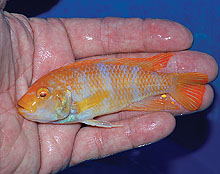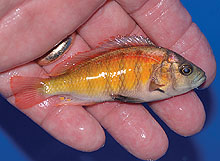WHAT'S NEW ACROSS THE WORLD
Select date in side bar to go to a What's New of previous issues
| What's New
©by Laif DeMason
Well, the kids are back to school and there is a hint of colder weather coming. Maybe it is time to take stock of your aquariums and see if there is a need for something new or different. Perhaps you can peruse the internet to see if your local fish club is hosting an auction or a meeting soon. No club or anything scheduled? Why not go down to a fish store that you haven’t been to in a while and see what’s there? It’s time to stop watching that cool youtube fish video for the twentieth time and go out and find your next aquarium guest!
Here’s “what’s new” on the cichlid scene: |
Lake Tanganyika
The popularity of Tanganyika cichlids is still strong amongst the Rift Lake hobbyists. There has been an uptick in interest in different Cyphotilapia frontosa types, along with Xenotilapia and Cyprichromis species, as well as odd-ball lamprologines. Exporters have slowly accommodated these different requests, although the main varieties sold are still Tropheus and Petrochromis.
|
WHAT'S NEW: LAKE TANGANYIKA
|
 Caught in the past infrequently but exported recently again, Neolamprologus mustax from Mbita Island, Zambia. This location has the deepest orange coloration, rivaling the best orange N. leleupi around. When I first saw these brilliant gems on location in 1989, I had to double check to be sure they weren’t N. leleupi! Photo by A. Konings.
Caught in the past infrequently but exported recently again, Neolamprologus mustax from Mbita Island, Zambia. This location has the deepest orange coloration, rivaling the best orange N. leleupi around. When I first saw these brilliant gems on location in 1989, I had to double check to be sure they weren’t N. leleupi! Photo by A. Konings.
|
 Another species that nearly slipped into aquarium oblivion is Neolamprologus buescheri. Here is the strain from Gombi (Kombe), Zambia which has been collected and shipped again, reminding us old-timers how incredibly small wild females actually are! Photo by A. Konings.
Another species that nearly slipped into aquarium oblivion is Neolamprologus buescheri. Here is the strain from Gombi (Kombe), Zambia which has been collected and shipped again, reminding us old-timers how incredibly small wild females actually are! Photo by A. Konings.
|
 A giant torpedo cichlid is the best way to describe Lepidiolamprologus profundicola. You’ll need a large aquarium with large cichlid tankmates, which is the best way to keep these beasts, as well as a big wallet as these large fish are expensive to ship!
A giant torpedo cichlid is the best way to describe Lepidiolamprologus profundicola. You’ll need a large aquarium with large cichlid tankmates, which is the best way to keep these beasts, as well as a big wallet as these large fish are expensive to ship!
|
 Reportedly from Karilani Island, Tanzania, Cyphotilapia frontosa was recently exported from an infrequently collected area for frontosa. This fish still has six bars but shows a bit of the dorsal fin coloration often seen in the seven bar strain.
Reportedly from Karilani Island, Tanzania, Cyphotilapia frontosa was recently exported from an infrequently collected area for frontosa. This fish still has six bars but shows a bit of the dorsal fin coloration often seen in the seven bar strain.
|
Lake Malawi
There is a surge of stronger interest in wild caught Malawi cichlids developing in some countries in Western Europe and the Far East. It is curious to note that hobbyists seem to have preferred favorite cichlid groups that are completely different from county to country. Exporters from Lake Malawi are, of course, happy to comply with whatever the demand is.

Species that exhibit OB coloration from the Metriaclima and Tropheops genera are in demand in countries like France and Sweden. Of course the male OB fish (Marmalade Cats) are especially sought after. Here a male OB M. fainzilberi from Makonde Tanzania. Photo by F. Callegari.
|

Malawi cichlid collectors have dug down into the species not exported in recent times to entice eager hobbyists to make purchases. Several haplochromine species like this Otopharynx sp. ‘big spot mpombo’ have started to appear on exporters lists again. Photo by F. Callegari.
|

In general, Petrotilapia are big and aggressive mbuna and are a challenge to keep in most aquaria. But the challenge is on! Pictured here P. flaviventris (“Yellow Ventral”) from Chizumulu Island, Malawi. Photo by F. Callegari.
|

Albino Malawi cichlids are produced from time to time by breeders. They are not, however, found in Lake Malawi as these genetic exceptions do not survive. Here is a farm-produced albino male OB Metriaclima zebra.
|
Lake Victoria
No new collections or exports of Victorian cichlids have occurred since the beginning of this year. Victoria fans hope for new wild material to become available, but for the time being captive bred varieties are the main source for hobbyists.
|
WHAT'S NEW: LAKE VICTORIA
|

Males of several similar cichlids from the Lake Victoria basin area have black bodies with red fins. When wild shipments contain these types of fishes, it is always a challenge to sort and identify them. Earlier this year this fish was offered as ‘Haplochromis’ sp. ‘velvet black’ from Makobe Island; a best guess.
|

For me, it was interesting to find that commercial production still continues on a fish we imported almost two decades ago. In the mid 1990s we imported twice from Uganda a fish called ‘Haplochromis’ sp. ‘tomato’ reportedly from Kome Island. Sadly, these were the last wild shipments available from Uganda.
|
Select date in side bar to go a What's New of previous issues |
 Caught in the past infrequently but exported recently again, Neolamprologus mustax from Mbita Island, Zambia. This location has the deepest orange coloration, rivaling the best orange N. leleupi around. When I first saw these brilliant gems on location in 1989, I had to double check to be sure they weren’t N. leleupi! Photo by A. Konings.
Caught in the past infrequently but exported recently again, Neolamprologus mustax from Mbita Island, Zambia. This location has the deepest orange coloration, rivaling the best orange N. leleupi around. When I first saw these brilliant gems on location in 1989, I had to double check to be sure they weren’t N. leleupi! Photo by A. Konings.
 Another species that nearly slipped into aquarium oblivion is Neolamprologus buescheri. Here is the strain from Gombi (Kombe), Zambia which has been collected and shipped again, reminding us old-timers how incredibly small wild females actually are! Photo by A. Konings.
Another species that nearly slipped into aquarium oblivion is Neolamprologus buescheri. Here is the strain from Gombi (Kombe), Zambia which has been collected and shipped again, reminding us old-timers how incredibly small wild females actually are! Photo by A. Konings.
 A giant torpedo cichlid is the best way to describe Lepidiolamprologus profundicola. You’ll need a large aquarium with large cichlid tankmates, which is the best way to keep these beasts, as well as a big wallet as these large fish are expensive to ship!
A giant torpedo cichlid is the best way to describe Lepidiolamprologus profundicola. You’ll need a large aquarium with large cichlid tankmates, which is the best way to keep these beasts, as well as a big wallet as these large fish are expensive to ship!
 Reportedly from Karilani Island, Tanzania, Cyphotilapia frontosa was recently exported from an infrequently collected area for frontosa. This fish still has six bars but shows a bit of the dorsal fin coloration often seen in the seven bar strain.
Reportedly from Karilani Island, Tanzania, Cyphotilapia frontosa was recently exported from an infrequently collected area for frontosa. This fish still has six bars but shows a bit of the dorsal fin coloration often seen in the seven bar strain.





